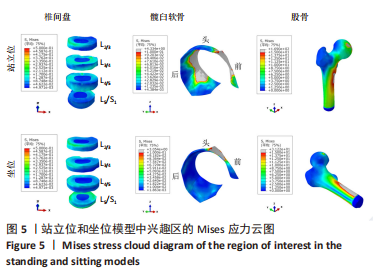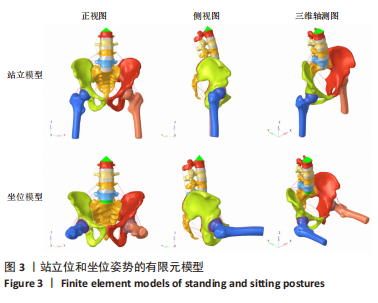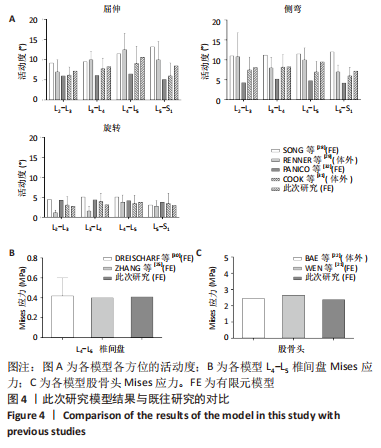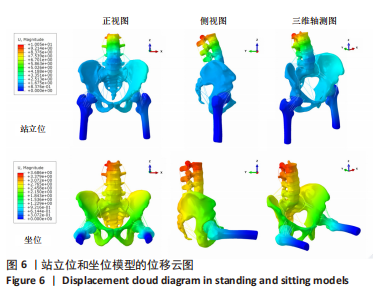Chinese Journal of Tissue Engineering Research ›› 2023, Vol. 27 ›› Issue (36): 5741-5746.doi: 10.12307/2023.708
Establishment of lumbar-pelvic-hip finite element model and biomechanical analysis
Wen Pengfei1, Li Yaning2, Lu Yufeng1, Hao Linjie1, Wang Yakang1, Ma Tao1, Song Wei1, Zhang Yumin1
- 1Department of Joint Surgery, 2Department of Radiology, Honghui Hospital, Xi’an Jiaotong University, Xi’an 710054, Shaanxi Province, China
-
Received:2022-10-15Accepted:2022-11-14Online:2023-12-28Published:2023-03-24 -
Contact:Zhang Yumin, Professor, Master’s supervisor, Department of Joint Surgery, Honghui Hospital, Xi’an Jiaotong University, Xi’an 710054, Shaanxi Province, China -
About author:Wen Pengfei, MD, Attending physician, Department of Joint Surgery, Honghui Hospital, Xi’an Jiaotong University, Xi’an 710054, Shaanxi Province, China -
Supported by:the Key Research and Development Program in Social Development Fied of Shaanxi Province, No. 2022SF‑237 (to ZYM)
CLC Number:
Cite this article
Wen Pengfei, Li Yaning, Lu Yufeng, Hao Linjie, Wang Yakang, Ma Tao, Song Wei, Zhang Yumin. Establishment of lumbar-pelvic-hip finite element model and biomechanical analysis[J]. Chinese Journal of Tissue Engineering Research, 2023, 27(36): 5741-5746.
share this article
Add to citation manager EndNote|Reference Manager|ProCite|BibTeX|RefWorks

2.3 不同姿势下应力分布的比较 此次研究构建了站立位和坐位两种姿势的有限元模型。模型通过上述验证后,进一步获取了2种模型中感兴趣部位(椎间盘、髋臼软骨、股骨)的应力云图,分析比较在姿势变化中应力云图的变化规律。从图5可知,在站立位,L2-S1椎间盘内的应力分布较均匀,而在坐位时L4-L5及L5-S1椎间盘的Mises应力呈上升趋势。从站立位到坐位,L5-S1椎间盘的平均Mises应力从(0.17±0.02) MPa升高至(0.26±0.03) MPa,差异有显著性意义(P < 0.001)。对于髋臼软骨处的Mises应力分布而言,在站立位时,应力在髋臼的前上后3个方向都有分布,而在坐位时应力则主要集中在前部。在髋臼前方区域,平均Mises应力从站立位(2.14±0.26) MPa上升到坐位(2.49±0.28) MPa,差异有显著性意义(P=0.009)。另外,由图可见,在站立位时应力在股骨颈及小转子处较为集中,而坐位时股骨颈和小转子处则无明显应力集中。"

| [1] OFFIERSKI CM,MACNAB I. Hip-spine syndrome. Spine (Phila Pa 1976). 1983;8(3):316-321. [2] VASWANI R, WHITE AE, FEINGOLD J, et al. Hip-Spine Syndrome in the Nonarthritic Patient. Arthroscopy. 2022;38(10):2930-2938. [3] OKUZU Y, GOTO K, OKUTANI Y, et al. Hip-Spine Syndrome: Acetabular Anteversion Angle Is Associated with Anterior Pelvic Tilt and Lumbar Hyperlordosis in Patients with Acetabular Dysplasia: A Retrospective Study. JB JS Open Access. 2019;4(1):e0025. [4] ANAND N, COHEN RB, COHEN J, et al. The Influence of Lordotic cages on creating Sagittal Balance in the CMIS treatment of Adult Spinal Deformity. Int J Spine Surg. 2017;11:23. [5] AN VVG, PHAN K, SIVAKUMAR BS, et al. Prior Lumbar Spinal Fusion is Associated With an Increased Risk of Dislocation and Revision in Total Hip Arthroplasty: A Meta-Analysis. J Arthroplasty. 2018;33(1):297-300. [6] WYATT MC, KUNUTSOR SK, BESWICK AD, et al. Outcomes following primary total hip arthroplasty with pre-existing spinal fusion surgery. Bone Joint J. 2020;102-b(6):664-670. [7] MALKANI AL, HIMSCHOOT KJ, ONG KL, et al. Does Timing of Primary Total Hip Arthroplasty Prior to or After Lumbar Spine Fusion Have an Effect on Dislocation and Revision Rates? J Arthroplasty. 2019;34(5): 907-911. [8] NESSLER JM, MALKANI AL, SACHDEVA S, et al. Use of dual mobility cups in patients undergoing primary total hip arthroplasty with prior lumbar spine fusion. Int Orthop. 2020;44(5):857-862. [9] BREKELMANS WA, POORT HW, SLOOFF TJ. A new method to analyse the mechanical behaviour of skeletal parts. Acta Orthop Scand. 1972; 43(5):301-317. [10] 潘爱星, 刘玉增, 海涌, 等. 腰椎皮质骨螺钉联合椎弓根螺钉固定对融合节段应力影响的有限元分析[J]. 中国脊柱脊髓杂志,2022, 32(1): 67-74. [11] SHI D, WANG F, WANG D, et al. 3-D finite element analysis of the influence of synovial condition in sacroiliac joint on the load transmission in human pelvic system. Med Eng Phys. 2014;36(6):745-753. [12] VAFAEIAN B, ZONOOBI D, MABEE M, et al. Finite element analysis of mechanical behavior of human dysplastic hip joints: a systematic review. Osteoarthritis Cartilage. 2017;25(4):438-447. [13] NEWELL E, DRISCOLL M. Investigation of physiological stress shielding within lumbar spinal tissue as a contributor to unilateral low back pain: A finite element study. Comput Biol Med. 2021;133:104351. [14] KIAPOUR A, MASSAAD E, JOUKAR A, et al. Biomechanical analysis of stand-alone lumbar interbody cages versus 360 degrees constructs: an in vitro and finite element investigation. J Neurosurg Spine. 2021:1-9. [15] 刘慧, 张喜林, 周楠, 等. 步态仿真下腰椎间盘退变合并骶髂关节紊乱的有限元分析[J]. 医用生物力学,2017,32(1):46-53. [16] SONG Y, SHAO C, YANG X, et al. Biomechanical study of anterior and posterior pelvic rings using pedicle screw fixation for Tile C1 pelvic fractures: Finite element analysis. PLoS One. 2022;17(8):e0273351. [17] ROUSSOULY P, GOLLOGLY S, BERTHONNAUD E, et al. Classification of the normal variation in the sagittal alignment of the human lumbar spine and pelvis in the standing position. Spine (Phila Pa 1976). 2005; 30(3):346-353. [18] WANG W, PEI B, WU S, et al. Biomechanical responses of human lumbar spine and pelvis according to the Roussouly classification. PLoS One. 2022;17(7):e0266954. [19] HEY HWD, TEO AQA, TAN KA, et al. How the spine differs in standing and in sitting-important considerations for correction of spinal deformity. Spine J. 2017;17(6):799-806. [20] DE CARVALHO DE, SOAVE D, ROSS K, et al. Lumbar spine and pelvic posture between standing and sitting: a radiologic investigation including reliability and repeatability of the lumbar lordosis measure. J Manipulative Physiol Ther. 2010;33(1):48-55. [21] WEN PF, GUO WS, ZHANG QD, et al. Significance of Lateral Pillar in Osteonecrosis of Femoral Head: A Finite Element Analysis. Chin Med J (Engl). 2017;130(21):2569-2574. [22] BAE JY, KWAK DS, PARK KS, et al. Finite element analysis of the multiple drilling technique for early osteonecrosis of the femoral head. Ann Biomed Eng. 2013;41(12):2528-2537. [23] ZHU J, SHEN H, CUI Y, et al. Biomechanical Evaluation of Transforaminal Lumbar Interbody Fusion with Coflex-F and Pedicle Screw Fixation: Finite Element Analysis of Static and Vibration Conditions. Orthop Surg. 2022;14(9):2339-2349. [24] LIU J, HE X, NIU B, et al. Biomechanical properties of a novel nonfusion artificial vertebral body for anterior lumbar vertebra resection and internal fixation. Sci Rep. 2021;11(1):2632. [25] ZHANG NZ, XIONG QS, YAO J, et al. Biomechanical changes at the adjacent segments induced by a lordotic porous interbody fusion cage. Comput Biol Med. 2022;143:105320. [26] WEN P, ZHANG Y, HAO L, et al. The effect of the necrotic area on the biomechanics of the femoral head - a finite element study. BMC Musculoskelet Disord. 2020;21(1):211. [27] DU CF, CAI XY, GUI W, et al. Does oblique lumbar interbody fusion promote adjacent degeneration in degenerative disc disease: A finite element analysis. Comput Biol Med. 2021;128:104122. [28] SONG M, SUN K, LI Z, et al. Stress distribution of different lumbar posterior pedicle screw insertion techniques: a combination study of finite element analysis and biomechanical test. Sci Rep. 2021;11(1): 12968. [29] RENNER SM, NATARAJAN RN, PATWARDHAN AG, et al. Novel model to analyze the effect of a large compressive follower pre-load on range of motions in a lumbar spine. J Biomech. 2007;40(6):1326-1332. [30] DREISCHARF M, ZANDER T, SHIRAZI-ADL A, et al. Comparison of eight published static finite element models of the intact lumbar spine: predictive power of models improves when combined together. J Biomech. 2014;47(8):1757-1766. [31] COOK DJ, YEAGER MS, CHENG BC. Range of motion of the intact lumbar segment: a multivariate study of 42 lumbar spines. Int J Spine Surg. 2015;9:5. [32] PANICO M, BASSANI T, VILLA TMT, et al. The Simulation of Muscles Forces Increases the Stresses in Lumbar Fixation Implants with Respect to Pure Moment Loading. Front Bioeng Biotechnol. 2021;9:745703. [33] ZHANG S, CHEN Y, REN R, et al. Quantitative study on the biomechanical mechanism of sacroiliac joint subluxation: A finite element study. J Orthop Res. 2022;40(5):1223-1235. [34] 司高,李彤,于淼,等. 成人脊柱侧凸患者长节段脊柱融合术后髋关节疼痛与脊柱-骨盆-髋关节参数的相关性分析[J]. 中国脊柱脊髓杂志,2018,28(11):989-994. [35] YANG DS, LI NY, MARIORENZI MC, et al. Surgical Treatment of Patients With Dual Hip and Spinal Degenerative Disease: Effect of Surgical Sequence of Spinal Fusion and Total Hip Arthroplasty on Postoperative Complications. Spine (Phila Pa 1976). 2020;45(10):E587-E593. [36] MENON RG, ZIBETTI MVW, PENDOLA M, et al. Measurement of Three-Dimensional Internal Dynamic Strains in the Intervertebral Disc of the Lumbar Spine With Mechanical Loading and Golden-Angle Radial Sparse Parallel-Magnetic Resonance Imaging. J Magn Reson Imaging. 2021;54(2):486-496. [37] ZHOU Z, NI HJ, ZHAO W, et al. Percutaneous Endoscopic Lumbar Discectomy via Transforaminal Approach Combined with Interlaminar Approach for L4/5 and L5/S1 Two-Level Disc Herniation. Orthop Surg. 2021;13(3):979-988. [38] 刘彩银, 欧阳文辉, 黄俊远. 基于有限元分析骨盆前后倾斜对髋关节应力的影响[J]. 赣南医学院学报,2022,42(1):12-15. [39] PIERANNUNZII L. Femoroacetabular impingement: question-driven review of hip joint pathophysiology from asymptomatic skeletal deformity to end-stage osteoarthritis. J Orthop Traumatol. 2019;20(1):32. [40] MALLOY P, WICHMAN DM, GARCIA F, et al. Impaired Lower Extremity Biomechanics, Hip External Rotation Muscle Weakness, and Proximal Femoral Morphology Predict Impaired Single-Leg Squat Performance in People With FAI Syndrome. Am J Sports Med. 2021;49(11):2984-2993. [41] THUMMALA AR, XI Y, MIDDLETON E, et al. Does surgery change pelvic tilt: an investigation in patients with osteoarthritis of the hip, dysplasia, and femoroacetabular impingement. Bone Joint J. 2022;104-B(9): 1025-1031. |
| [1] | Fang Xingyan, Tian Zhenli, Zhao Zheyi, Wen Ping, Xie Tingting. Effects of sodium arsenite on human umbilical vein endothelial cell injury and sphingosine kinases 1/sphingosine 1-phosphate signaling axis [J]. Chinese Journal of Tissue Engineering Research, 2023, 27(在线): 1-7. |
| [2] | . Changes in Lumbosacral Sagittal Plane Parameters of L5/S1 Disc Herniation [J]. Chinese Journal of Tissue Engineering Research, 2023, 27(在线): 1-6. |
| [3] | Guo Shuhui, Yang Ye, Jiang Yangyang, Xu Jianwen. Screening and validation of neurogenic bladder miRNA-mRNA regulatory network [J]. Chinese Journal of Tissue Engineering Research, 2023, 27(在线): 1-8. |
| [4] | Zhong Yizheng, Huang Peizhen, Cai Qunbin, Zheng Liqin, He Xingpeng, Dong Hang. Microstructural indexes that determine the trabecular bone maximum stress of micro-finite element models [J]. Chinese Journal of Tissue Engineering Research, 2023, 27(9): 1313-1318. |
| [5] | Wu Taoguang, Nie Shaobo, Chen Hua, Zhu Zhengguo, Qi Lin, Tang Peifu. Biomechanical characteristics of a new multi-dimensional cross locking plate in the treatment of subtrochanteric nonunion [J]. Chinese Journal of Tissue Engineering Research, 2023, 27(9): 1330-1334. |
| [6] | Tang Huiyu, Hou Biao, Xia Xiaodan, Xiang Wei, Xie Songlin. Effect of mechanical tension stress on arterial vessels after limb osteotomy in rabbits [J]. Chinese Journal of Tissue Engineering Research, 2023, 27(9): 1422-1426. |
| [7] | Peng Zhixin, Yan Wengang, Wang Kun, Zhang Zhenjiang. Finite element analysis and structural optimization design of 3D printed forearm braces [J]. Chinese Journal of Tissue Engineering Research, 2023, 27(9): 1340-1345. |
| [8] | Wu Tianliang, Tao Xiuxia, Xu Hongguang. Influence of different bone mineral densities on cage subsidence after stand-alone oblique lateral interbody fusion: three-dimensional finite element analysis [J]. Chinese Journal of Tissue Engineering Research, 2023, 27(9): 1352-1358. |
| [9] | Liu Jinyu, Zhang Hanshuo, Cui Hongpeng, Pan Lingzhi, Zhao Boran, Li Fei, Ding Yu. Finite element biomechanical analysis of minimally invasive treatment of cervical spondylotic myelopathy and accurate exercise rehabilitation [J]. Chinese Journal of Tissue Engineering Research, 2023, 27(9): 1359-1364. |
| [10] | He Yujie, Kang Zhijie, Xue Mingming, Jin Feng, Li Zhijun, Wang Xing, Xu Yangyang, Gao Mingjie, Li Jiawei, Li Xiaohe, Wang Haiyan. Finite element analysis of transarticular screw fixation of adolescent thoracic vertebra [J]. Chinese Journal of Tissue Engineering Research, 2023, 27(9): 1365-1370. |
| [11] | Wen Xinghua, Ding Huanwen, Cheng Kai, Yan Xiaonan, Peng Yuanhao, Wang Yuning, Liu Kang, Zhang Huiwu. Three-dimensional finite element model analysis of intramedullary nailing fixation design for large femoral defects in Beagle dogs [J]. Chinese Journal of Tissue Engineering Research, 2023, 27(9): 1371-1376. |
| [12] | Ke Yuqi, Chen Changjian, Wu Hao, Zheng Lianjie. Comparison of 12-month follow-up results of primary total hip arthroplasty between modified direct anterior approach and direct anterior approach [J]. Chinese Journal of Tissue Engineering Research, 2023, 27(9): 1377-1382. |
| [13] | Zheng Hongrui, Zhang Wenjie, Wang Yunhua, He Bin, Shen Yajun, Fan Lei. Femoral neck system combined with platelet-rich plasma in the treatment of femoral neck fracture [J]. Chinese Journal of Tissue Engineering Research, 2023, 27(9): 1390-1395. |
| [14] | You Zhengqiu, Zhang Zhongzu, Wang Qunbo. Early symptomatic intervertebral disc pseudocysts after discectomy detected on MRI [J]. Chinese Journal of Tissue Engineering Research, 2023, 27(9): 1403-1409. |
| [15] | Li Chao, Zhang Peipei, Xu Mengting, Li Linlin, Ding Jiangtao, Liu Xihua, Bi Hongyan. Respiratory training improves morphological changes of the multifidus muscle in patients with chronic nonspecific lower back pain assessed by musculoskeletal ultrasound [J]. Chinese Journal of Tissue Engineering Research, 2023, 27(9): 1417-1421. |
| Viewed | ||||||
|
Full text |
|
|||||
|
Abstract |
|
|||||





